Trace of the Beauties
36 Japanese master-poets
Cat: HIS
Pub: 1984
#: 9010b
Kenichi Yamamoto
90332u/18207r
Title
Trace of the beauties
美女たちの行方
Author
Kenichi Yamamoto
山本健一
Published
1984
1984年
Index
Why?
- I found an old news clipping of Sankei Shimbun dated Jan 9, 1984,
which is an article of Kenkichi Yamamoto, author. I still remember
NHK TV program mentioned in this article.
- Since then, the poets and poems millennium ago became my interest.
They expressed lives, feelings, affection and flow of time in such
short 17 syllables of 5-7-5-7-7 of Japanese poem format called Waka.
How they feel such communicative age using Internet?
- Following paragraph from 1 to 5 is quotation from the article.
- 古い新聞の切り抜きが出てきた。1984.1.9サンケイ新聞に掲載された作家山本健吉氏の記事である。小生もこの話題を放送したNHK番組の印象が今でも鮮明に残っている。
- あの時以来、小野小町など千年も前の歌人たちのことが気になっている。言葉豊かに、想像力を働かせて、人生と時流れとを見事に切り取って表現した歌仙たちは、饒舌なインターネット時代をどう思うだろうか?
- なお、以下1 -5 は上記記事の引用である。
Summary
要約
>Top 1. 36
Master-poets (Satake-bon):
- Kinto Fujiwara, a famous poet of 10th century
selected 36 master-hand of poets; whose portraits and poems remained.
One of them is 'Satake-bon', whose portraits were painted
by Nobuzane Fujiwara, and scripts were written by Yoshitsune
Gokyogoku. It is the oldest and the best existing pictures.
Besides 36 poems, landscape and the picture of Sumiyoshi Shrine
was attached and constitute 37 pictures in total.
- At the time of Taisho era (1912-26), the pictures were sold to Tadasaburo Yamamoto in 1917, but again it was tendered
in the following year at the price of 360,000 yen. Then the venerable
Mr. Masuda (Don'oh) invited 37 tenderers in his village at Hakone,
and tried to distribute it in each separated picture by lottery.
1. 佐竹本三十六歌仙:
- 歌仙絵とは、藤原公任 (10世紀) が撰んだ「三十六人撰」の歌人の姿と歌とを書いた絵巻を言う。幾種類もある中で、佐竹家に伝わった一本は、絵は藤原信実筆、時は後京極良経筆と伝えられる。現存最古の歌仙絵で、同時に屈指の名作である。この36枚のほかに、下巻冒頭に住吉明神の風景と絵とが添えられていて37枚になった。
- 大正時代になって、佐竹家から売りに出され、同6年に山本唯三郎の所有となった。それも不況下の8年に、ふたたび入札されることになったが、36万円という高額では引き取り手がなく、益田鈍翁の肝いりで、翁の箱根山荘で、一歌仙づつ分断されることとなり、37人の希望者を集めて、抽選でその行く先が決められた。
>Top 2. Masuda Don'oh won a monk:
-
Don'oh who arranged all settings, but became displeased after
being allotted to a poem of a monk. A participant who won a poem
of Onono-komachi unavoidably offered to transfer
it to Don'oh. We can imagine vividly how Don'oh recovered humor,
because he has been a famous tea-master and a collector of excellent
art objects.
- But during the last half century, 37 collectors parted with the
poem except Sumitomo family. NHK broadcast program described how
to trace the unknown poems, and the last poem written by Saigu-no-Nyogo finally discovered which was owned by Mr. Setsuzo Hinohara of former
president of Showa Denko Co. It has been kept in the warehouse of
Mitsui Bank, and the trace of all poem succeeded.
2. 坊主が当たった鈍翁:
- ところが、それまでの段取りをつけた鈍翁は、籤で坊主の絵が当たって、はなはだ機嫌が悪かった。小町を抽き当てた人が見かねて、鈍翁に小町を譲ったので、どうやら機嫌を直したという。あの近世指折りの茶人といわれ、茶器や美術品のすぐれた蒐集家であった鈍翁のその時の表情が、彷彿と浮かぶようである。
- だが、そのとき37枚の歌仙絵をそれぞれ取得した人たちは、その後50余年のあいだに、住友家を除き手放してしまい、中には所在不明のものも生じた。二転、三転したその行方を一枚一枚、突き止めようとしたのがこの番組で、最後にどうしても不明であった斎宮女御の一枚が、前の昭和電工社長、日野原節三氏の所有となって、三井銀行の倉庫に眠っていたことを突きとめ、ようやく全部の所在が判明したのだった。
>Top 3. Same trend of taste:
- It was a lucky case that such divided pictures could be all traced.
Other versions of pictures like Kamigajo-bon, Gotobajoko-bon, Nishu-bon
still remain partly unknown except serveral or more remained pieces. Satake-bon's case was lucky because it was divided in relatively
recent days with remained its record, and also it could survive
in complete during the last world war and confused postwar period.
- It is an interesting story that Don'oh who won a monk and became
displeased. We have similar experience in our younger days in playing
turning up poetry cards, when we won women poets we felt happy but
monks unhappy. The famous Don'oh showed the same sentiment as he
returned to his old boy's days. There are only two monks n 36 cards;
Monk Henjo and monk Sosei, who are a father and a
son. Regarding to the prices, the monk were cheaper same as the
popularity of the general public.
3. 一般の好みも同じ:
- 佐竹本が分断されながら、ともかく全体の所在が突きとめられたのは、幸運な例である。上ケ畳本、後鳥羽院本、二首本その他、どれも数枚あるいは十数枚の残欠が知られているだけで、全体はわからない。佐竹本は分断された時期が新しく、その記録も残っていたからでもあるが、それでも大戦の時期、戦後の混乱期を経て、ともかく無事であったというのは、何と言ってもめでたい。
- だが、さしもの鈍翁に、坊主が当たって不機嫌になった話は、思わず笑ってしまった。私たちが少年時代に、坊主めくりで坊主をめくった時の気持ちと同じではないか。鈍翁も坊主めくりをやった昔に返ったのだろう。子供のような無心の欲望だ。三十六歌仙で坊主といったら、僧正遍昭と素性法師の親子である。絵の値段も坊主が一番やすいのだとは、一般の好みも子供や鈍翁と同じなのか。
>Top 4. The
only royal family:
- On the contrary, women poets are popular. There are 5 women among
36 poets; 1) Saigu-no-Nyogo, 2) Kodai-no-kimi, 3)
Ise, 4) Komachi, 5) Nakatsukasa. When we played
poetry card, women poems called 'Hime (princess)' are favorite.
The most expensive and the lastly found was Saigu-no-Nyogo who only belongs to the royal family, sitting on double tatami mat with shoji curtain and specially designed partition.
She wears luxurious gown in bending position, who takes unique pose
with noble sense showing delicate lines of kimono. Her poem
is also marvelous:
- - Matsu noneni mineno matsu-kaze kayofurashi idureno oyori
sirabe somekemu
- (The strains of koto harp drifted in with soughing winds
among the pine trees, I can't distinguish which string is making
the melody.)
- Don'oh probably wanted this poem, but as an alternative he satisfied
to have Komati, wasn't he. The painter refrained from painting
the real beauty face of komachi, who was painted backward.
It is understood that the women poets are described as in contrasted
patterns; Ise was painted obliquely from right side, Nakatsukasa obliquely from left side, Kodai-no-kimi almost straight from
front, but komachi backward.
4. たった一人の皇族:
- 一番欲しがられるのは、女流で、36人の中で5人、1) 斎宮女御、2) 小大君、3) 伊勢、4) 小町、5) 中務である。私たちも昔、「ひめ」と言って、歌がるたでは女の絵札が好きだった。値段も、女の絵が高いという。一番高いのは、最後まで行方が分からなかった斎宮だった。たった一人の皇族で、上敷・下敷と畳二枚を二段に重ね、障子と几帳を立てて囲いとし、重ねうちぎで這い臥しの形で、構図としては一番凝っている。貴人として格別の配慮が加えられ、中央部から四方へほとばしる衣装の線が見事である。それに斎宮女御の歌がいい。
- 琴のねに峰の松風かよふらしいづれの緒よりしらべそめけむ
- この一枚を、鈍翁はやはり欲しかったのではないかろうか。だが、それに次ぐ一枚として小町を得て満足した。筆者は天下の美女小町の顔を描くのをはばかって、後ろ向きに書かれた一枚である。それは昔から言われていることだが、近ごろの学者は、伊勢右斜め向き、中務左斜め向き、小大君ほぼ正面向き、小町後ろ向きと、基本形の割り付けの上での変化を見せたとする。
>Top 5. Declined to paint the real beauty:
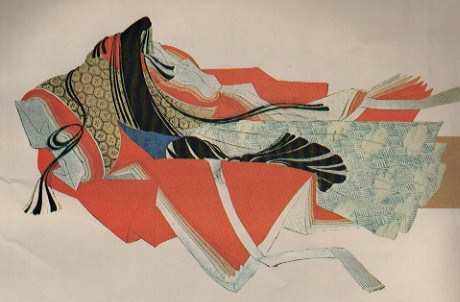
- There is a reason why komachi was painted backward, because
of her legendary beauty. The portrait of the real beauty is hard
to be described, as also is introduced in Kokin-wakashu,
the officially collected poems, as 'looks like pathologically
beautiful'.
-
The painter of komachi succeeded her portrait giving us
full of imagination. There is two other backward portrait of men
poets, but the case of komachi is totally different. She
has been so mysteriously beautiful.
-
Don'oh was delighted to have komachi's poem. The real
image of Komachi should be observed behind the mist, as
it were 'the secrecy gives more beauty to the flowers.'
5. 美貌を描くのを断念:
- だがそれにしても、その4人の変化の中で、とくに小町が後ろ向きなのは、彼女の美人伝説からである。「よき女の悩めるところある」 (古今集序) 姿なぞ、たやすく似せられるはずもない。
- 描くことを断念したこの歌仙絵の筆者こそ、心にくいと言うべきだろう。後ろ向き男姿には興風・朝忠と二枚あるが、片面 は斜め後ろから描かれている。全く容貌が描かれていない小町はそれだけ神秘化された美女だからだろう。
- 美貌を全くかくした後ろ向きの小町に、鈍翁は子供のように喜んだのだった。それこそ「秘スレバ花」ということだったのか。小町の実像は、やはり霞のとばりを隔てて眺めた方がよいのである。
Re:
>Top 6. Root of Oxymoron:
- We can find a root of oxymoron in the poet styles in Kokin-wakashu compiled in the beginning of Heian era (10C) in their rhetorical
dualism: One aspect is to describe social communication in the noble
class with refined sense of beauty, but on the hand to describe
perception of solitude and loneliness through expression of the
poets.
- The preface of Kokin-wakashu describes two components of
'mind" and 'words', as expressed in "Japanese poems
appeared in every sense of words derived from mind and sentiment
of the people."
- "Mind (kokoro)" and "words (kotoba)"
alliterate in Japanese.
6. Oxymoronのルーツ:
- この平安時代の初期に編纂された古今和歌集の歌風には、修辞上の二重性、いわばOxymoron (撞着語法) のルーツが見られる。一面では貴族的に洗練された美の世界にふけることを通して他者と交流しながら、一面では自己の孤心を見つめるという二重性をもっていた。
- 古今和歌集の序に「やまとうたは人に心を種として、よろづの言の葉とぞなれりける。」とあるように、「心」と「言葉」とに二要素に分析して、この交流を暗示している。
- 「こころ」と「ことば」とは同じ頭韻を踏んでいる。
>Top 7. Collection of poems of Ono-no-Komachi:
- Ono-no-komachi of 9th century, legendary top beauty, with no record of birth and
death, leaves us splendid poems mainly describing dreams and flow
of time. Followings are the most famous her poems.
- Hana-no irowa utsurini kerina otazurani waga miyoni furu nagame
sesimani.
(As long and weary rain changed the hue of
flowers, my beau yeux also have gone in vain during those lonely
years.)
- Omoitsutsu nurebaya hitono mietsuramu yumeto siriseba samezaramasiwo.
(I hoped to see my sweethart once again, with whom I met unawarely in my
dream. If I recognized it was a dream, I never wanted to be awakened.)
- Utataneni koishiki hitowo miteshiyori yume chofumonowa tanomi
someteki.
(Until then I thought dream was undependable,
but it looked dependable now after I met him in my dream.)
- Itosemete koishiki tokiwa mubatamano yoruwo koromowo kaeshitezo
kiru.
(Whenever I want to see him in my dream, I
lay down wearing night dress inside out as a legend says.)
- Akino yowa nanomi narikeri afuto aeba kotozo tomonaku akenuru
monowo.
(Usually autumn has lengthy night, but
it seems to dawn more rapid whenever I meet and talk with him.)
- Utsutunimo samokoso arame yumenisae hitomewo moruto miruga
subenasa.
(It has every reason to be easily noticed
in real events, so even in my dreams I try to have a secret meeting.)
- Kagirinaki omoino maniha yorumo komu yumejini saeni hitowa
togameji.
(Dreams always come with full of free imagination at night, which would be never watched by other in keeping perfect privacy.)
- Yumejiniha ashimo yasumezu kayoedomo ututuni hitome misikotowa
arazu
(In my dreams I paid frequent visits to him, but
in real events I have never seen him even once.)
- Imawatote wagami sigureni narinureba kotonoha saeni otoroini
keri.
(I spent many times in vain during lengthy drizzling
rains, also my words and feelings are losing vigorness)
- Iromiede utsurou monowa yononakano hitono kokorono hanani zarikeru.
(Change of color or tint of men's mind could not be recognized from outside unlike the that of flowers.)
- Wabinureba miwo ukikusano newo taete sasofu mizu araba inamu
tozo omofu.
(My life is lonely like a floating weed, and
if you picked it up for invitation I would be ready to follow. )
- Konomayori morikuru tukino kagemireba kokorozukusino akiha
kinikeri.
(Whenever I saw a moon between the trees,
I recognize and remember the return of autumn with full of uncertain sentiment. )
7. 小町小町の歌十二首:
- 千年も前の平安時代初期の伝説の美女小野小町は、夢と時の流れを意識した珠玉の歌を多く残している。「あはれなるやうにて強からず、いはば、よき女の、悩めるところあるに似たり。」
(古今集)
- 花の色は移りにけりないたづらにわが身世にふるながめせし間に
(世に経る=降る、眺め=長雨の掛詞。美貌も時間の関数ということか。)
- 思ひつつ寝ればや人の見えつらむ夢と知りせば覚めざらましを
(夢なら覚めないでおけばよかったのに...)
- うたたねに恋しき人を見てしより、夢てふものは頼みそめてき
(それまでは夢は頼りないと思っていたのに、頼みに思えてきた。)
- いとせめて恋いしき時はむばたまの夜を衣をかへしてぞ着る
(衣を裏返して着て寝ると恋人が夢に見えるという伝説)
- 秋の夜は名のみなりけり逢ふとあへばことぞともなく明けぬるものを
(秋の夜長なんて名ばかり。逢えば何ということもなく時が過ぎるのに。)
- うつつにはさもこそあらめ夢にさへ人目をもるとみるがすべなさ
(現実にはもっともなこと。夢でさえ人目をはばかるのだから...)
- 限りなき思ひのまには夜もこむ夢路にさへに人はとがめじ
(夢の世界ではどんなことをしても咎められないのだから..)
- 夢路には足も休めずかよへどもうつつに人目見しことはあらず
(夢というバーチャルな世界でのどんな交流もリアルには何もない)
- いまはとてわが身しぐれにふりぬれば言の葉さへにおとろひにけり
(時雨に降るように、古くなると言葉も衰えてくるのだろうか)
- 色見えで移ろうふものは世の中の人の心の花にざりける。
(人の心は移ろいやすく色のない空しいものだ。)
- わびぬれば身を浮き草の根を絶えて誘ふ水あらばいなむとぞ思ふ
(身は憂き草で根なしの浮き草のようで、誘い水があればついて行く。)
- 木の間よりもり来る月のかげ見れば、心づくしの秋は来にけり
(木々の間から漏れさす月を眺めると、あれこれ悩ませる秋がやってきた。)
斎宮女御
琴の音に峯の松風
かよふらし
いづれのは緒より
しらべそめけむ
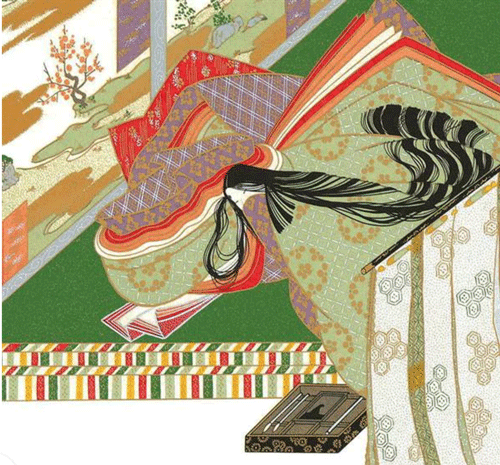
小野小町
いろ見えでうつろふものは
世の中の
人のこころの
はなにぞありける
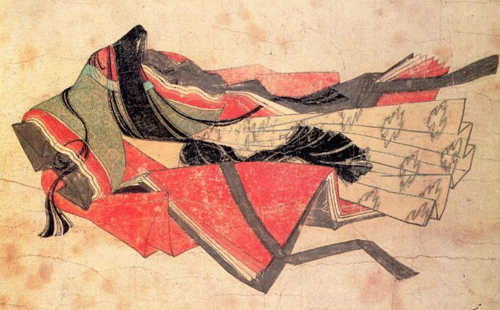
小大君
岩橋の夜の契りも
絶えぬべし
明くるわびしき
葛城の神
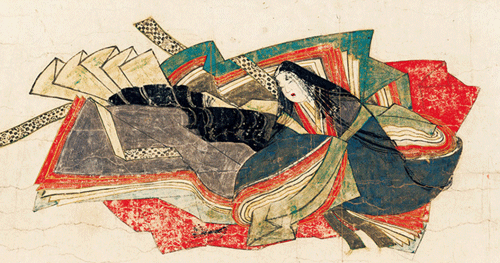
中務
うぐひすの声なかりせば
雪消えぬ
山里いかで春を
知らまし
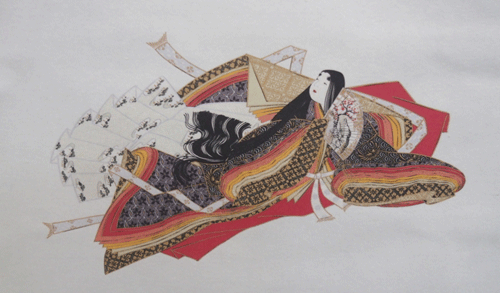
伊勢
三輪の山いかに待ち見む
年ふとも
たづぬる人も
あらじと思へば
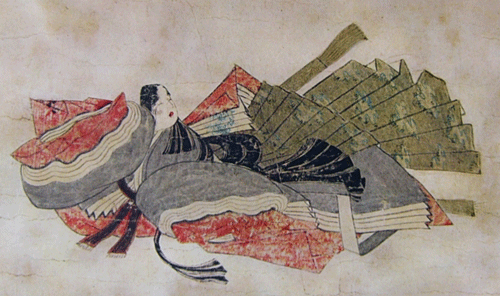
Comment
- If I could make travel a millennium backward, it was a world when
Ono-no-komachi made her poems.
- Now there remained no record about herself, when she was born
and how she lived, but she remained her message in the form of poem
to us across a millennium.
- The back picture of Onono Komachi was only available because of her unparalleled beauty and the post-in story of herself as a miserable old woman sitting on a wooden stupa (Sotoba Kobachi) which is taken as a Noh play look typical as Japanese stories.
- もし千年の昔に時間を遡れるのであれば、そこは小野小町が歌を詠んだ世界である。
- 彼女の生い立ちも記録も残っていないが、千年後の我々に彼女は歌でメッセージを残した。
- 類い希な美人の小野小町の後ろ姿しか描けなかった話や、能で取り上げられる卒塔婆小町の後日談は、実に日本的な物語である。
Trace of the Beauties36 Japanese master-poets |
Cat: HIS |
|
Kenichi Yamamoto |
90332u/18207r |
Title |
Trace of the beauties |
美女たちの行方 |
|---|---|---|
Author |
Kenichi Yamamoto | 山本健一 |
Published |
1984 |
1984年 |
Index |
||
Why? |
|
|
Summary |
要約 |
>Top 1. 36 Master-poets (Satake-bon):
|
1. 佐竹本三十六歌仙:
|
>Top 2. Masuda Don'oh won a monk:
|
2. 坊主が当たった鈍翁:
|
>Top 3. Same trend of taste:
|
3. 一般の好みも同じ:
|
>Top 4. The only royal family:
|
4. たった一人の皇族:
|
>Top 5. Declined to paint the real beauty:
|
5. 美貌を描くのを断念:
|
Re: |
>Top 6. Root of Oxymoron:
|
6. Oxymoronのルーツ:
|
>Top 7. Collection of poems of Ono-no-Komachi:
|
7. 小町小町の歌十二首:
|
斎宮女御
|
小野小町 いろ見えでうつろふものは
|
小大君
|
中務
|
伊勢
|
Comment |
|
|